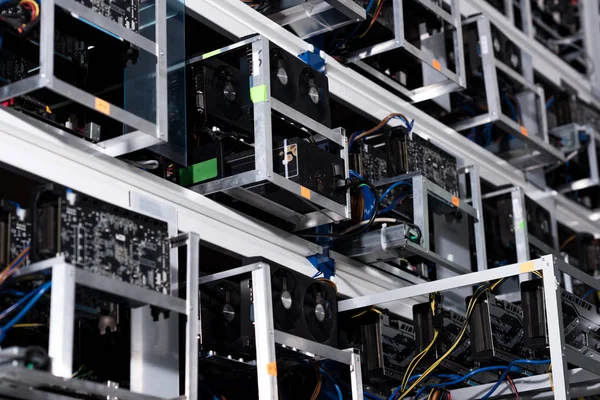Decoding Mining’s Essential Function in Crypto Networks
Understanding Mining’s Crucial Role in Cryptocurrency Ecosystems
The Foundation of Cryptocurrency: Mining Explained
Mining is a fundamental process in the cryptocurrency ecosystem that serves multiple critical functions. At its core, mining involves validating transactions and adding them to the blockchain, the secure and decentralized ledger underlying most cryptocurrencies. Miners use powerful computers to solve complex mathematical problems, a process known as proof-of-work, which not only verifies transactions but also creates new coins in the network. This dual function of mining is essential for maintaining the integrity and trustworthiness of the cryptocurrency system.
The mining process can be likened to a competitive lottery, where miners race to solve a cryptographic puzzle. The first miner to successfully solve the puzzle gets to add a new block to the blockchain and receives a reward, often in the form of newly minted cryptocurrency. This incentive system is crucial for motivating miners and ensuring their continued participation in the network, thereby providing stability and security to the ecosystem.
The importance of mining extends beyond transaction validation. It plays a pivotal role in decentralizing control over the network, which is a fundamental principle of cryptocurrencies. By allowing anyone with the necessary hardware and software to participate in mining, cryptocurrencies promote a democratized financial system devoid of central authority, which is particularly appealing in contexts where traditional banking systems may fail.
The rewards for mining are not static; they are designed to decrease over time in a process known as halving. This mechanism aims to control inflation and maintain the value of the cryptocurrency. Understanding these foundational aspects of mining is essential for anyone looking to engage with or invest in the cryptocurrency market.
How Mining Secures Blockchain Networks and Transactions
Mining secures blockchain networks through a combination of cryptographic techniques and economic incentives. Each block added to the blockchain contains a unique hash, which is generated based on the contents of the block and the hash of the previous block. This creates a chain of blocks that is immutable and transparent. Any attempt to alter the information in a block would require recalculating the hash for that block and every subsequent block, an almost impossible task without an extraordinary amount of computational power.
Moreover, the proof-of-work mechanism requires miners to expend resources—both computational and electrical—to validate transactions. This resource-intensive process acts as a deterrent against malicious attacks. To successfully execute a 51% attack, where a single entity gains control of the majority of the network’s computational power, that entity would need to invest heavily in mining infrastructure, making such attacks economically unviable for most.
Transaction verification through mining also contributes to the overall trustworthiness of the cryptocurrency ecosystem. With each new block added, a consensus is reached among miners and nodes regarding the validity of transactions. This consensus mechanism eliminates the need for a central authority and ensures that all participants can trust the system, thereby bolstering confidence among users and investors alike.
In essence, mining serves as the backbone of blockchain security, creating a tamper-proof environment where transactions can be conducted transparently and securely. This foundational role not only protects the asset itself but also fosters wider adoption of cryptocurrencies.
The Economic Impact of Mining on Cryptocurrency Markets
Mining has significant economic implications for cryptocurrency markets, influencing everything from coin valuation to market dynamics. As miners operate in a competitive environment, their activities directly affect the supply of new coins entering circulation. When mining rewards are high, more miners are incentivized to participate, potentially leading to increased supply. Conversely, as rewards decrease, the incentive for new miners diminishes, which can constrain supply and potentially elevate prices.
Additionally, mining operations can create localized economic impacts. Regions with access to cheap electricity or favorable regulatory environments often see a surge in mining activities. This leads to job creation, investment in technology, and, in some cases, infrastructure development, as mining companies often require substantial resources to maintain their operations. However, this localized impact is not uniform; some areas may experience economic downturns if mining operations leave due to unfavorable conditions.
Market speculation can also influence mining profitability. As prices for cryptocurrencies fluctuate, so do the incentives for miners. A significant increase in cryptocurrency prices can lead to a boom in mining activities, attracting new players into the market. Conversely, a steep decline in prices may result in miners shutting down operations, leading to decreased network security and potential long-term implications for the overall ecosystem.
The interplay between mining and market dynamics illustrates the complexity of the cryptocurrency economy. Understanding this economic impact is essential for investors and stakeholders, as it can inform strategies for navigating the volatile landscape of digital assets.
Environmental Concerns: Mining’s Carbon Footprint Explored
Mining, particularly proof-of-work mining, has come under scrutiny for its environmental impact. The process of validating transactions and adding them to the blockchain requires significant computational power, which translates into substantial electricity consumption. Studies have estimated that Bitcoin mining alone consumes as much energy as entire countries, raising concerns about the sustainability of such operations.
The carbon footprint associated with mining activities is particularly troubling. Many mining operations rely on fossil fuels, which contribute to greenhouse gas emissions. This reliance not only exacerbates climate change but also creates a moral dilemma for investors and consumers who are increasingly prioritizing sustainability in their choices. As awareness of environmental issues grows, there is mounting pressure on the cryptocurrency industry to adopt more sustainable practices.
In response to these concerns, discussions around transitioning to greener alternatives, such as proof-of-stake (PoS), have gained momentum. PoS significantly reduces energy consumption by allowing validators to create new blocks based on the number of coins they hold rather than competing to solve complex puzzles. This shift could mitigate the environmental impact of mining while maintaining the integrity of blockchain networks.
Consequently, the discourse around mining’s carbon footprint is evolving. Many in the industry are beginning to explore renewable energy sources to power mining operations, with some companies investing in solar, wind, and hydroelectric energy. As the cryptocurrency ecosystem matures, addressing environmental concerns will be crucial for its long-term viability and acceptance.

Innovations in Mining Technology: Efficiency and Sustainability
The landscape of mining technology is rapidly evolving, driven by the need for greater efficiency and sustainability. Innovations in hardware, such as the development of Application-Specific Integrated Circuits (ASICs), have revolutionized mining operations. These specialized chips are designed specifically for cryptocurrency mining, providing significantly higher hash rates while consuming less power compared to traditional GPU setups.
Moreover, software advancements, including optimized mining algorithms, have improved the overall efficiency of mining operations. Miners are now able to better analyze market conditions, electricity costs, and network difficulty to maximize their profitability. This technological evolution has not only increased competitiveness in the mining space but has also contributed to a more sophisticated approach to resource management.
Sustainable mining practices are gaining traction as well. Many miners are now focusing on utilizing renewable energy sources to power their operations, reducing their carbon footprint. Initiatives like “green mining” promote the use of excess energy from renewable sources, such as solar and wind, to support mining activities. Such practices not only alleviate environmental concerns but can also lead to reduced operational costs.
As the cryptocurrency ecosystem continues to mature, the emphasis on efficient and sustainable mining practices will likely drive innovation further. This ongoing evolution will play a vital role in addressing environmental issues while ensuring the security and functionality of blockchain networks.
The Future of Mining: Trends Shaping the Crypto Landscape
The future of mining is poised for transformation, influenced by technological advancements, regulatory changes, and shifting market dynamics. One of the most significant trends is the transition from traditional proof-of-work systems to more energy-efficient mechanisms like proof-of-stake. This shift not only reduces the environmental impact of mining but also democratizes the process, allowing more individuals to participate without the need for expensive hardware.
Another noteworthy trend is the rise of mining pools. As individual mining becomes increasingly challenging due to competition and network difficulty, miners are banding together to form pools that combine their resources. This collaborative approach allows participants to share rewards more equitably and enhances network security, as it decentralizes the process further. The evolution of mining pools could reshape the competitive landscape of cryptocurrency mining in the coming years.
Furthermore, government regulations are beginning to shape the mining environment. Authorities around the world are increasingly scrutinizing mining operations, particularly concerning their environmental impact. In some regions, this has led to the imposition of stricter regulations, while others have embraced mining as a means of economic growth. As regulatory frameworks evolve, they will significantly influence where and how mining operations are conducted.
Lastly, the integration of artificial intelligence and machine learning into mining operations holds great promise. These technologies can optimize energy consumption, predict market trends, and improve mining efficiency. By leveraging data analytics, miners can make informed decisions that enhance their competitiveness in an ever-changing landscape. The convergence of these trends suggests a dynamic future for mining, one that prioritizes sustainability, efficiency, and adaptability in the cryptocurrency ecosystem.
| Aspect | Proof of Work | Proof of Stake |
|---|---|---|
| Energy Consumption | High | Low |
| Decentralization | Moderate | High |
| Barrier to Entry | High (cost of hardware) | Low (coin ownership) |
| Security Model | Competitive computation | Economic stake |
| Environmental Impact | Significant | Minimal |
In conclusion, understanding mining’s crucial role in cryptocurrency ecosystems is essential for grasping the broader implications of digital currencies. The balance between innovation, profitability, and sustainability will determine the future of mining and its impact on the global financial landscape.









Nice to know mining helps decentralize control over the network.
The comparison to a competitive lottery made understanding mining easier.
I understand now that mining supports the trustworthiness of the cryptocurrency system.
I did not know that mining creates new coins in the network. Very informative.
This article explains well how mining validates transactions in the blockchain.
The idea of proof-of-work helps to keep the blockchain secure. Very well explained.
The article explains that mining has both local and global economic impacts on the market.
Mining requires a lot of resources, which makes malicious attacks difficult and expensive.
This article explains how mining secures transactions through cryptographic techniques.
I learned that the rewards for mining decrease over time. Interesting!